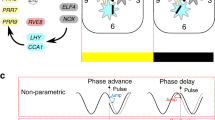Summary
The control of the circadian rhythm of transpiration inTamarix aphylla seems to include two distinct components: an externally induced one, that is initiated by the ‘light on’ signal, and an endogenous clock, whose memorization of the period length is independent of the instant environmental signal.
Similar content being viewed by others
References
Bunning, E., the Physiological Clock. Springer Verlag, New York 1973.
Sweeney, B. M., Rev. Plant Physiol.14 (1963) 411.
Hagemeyer, J., and Waisel, Y., Physiol. Plant.70 (1987) 133.
Waisel, Y., Phyton15 (1960) 17.
Pittendrigh, C. S., Proc. natl Acad. Sci. USA40 (1954) 1018.
Martin, E. S., and Meidner, H., New Phytol.70 (1971) 923.
Pavlidis, Th., Biological Oscillators: Their Mathematical Analysis. Academic Press, New York 1973.
Author information
Authors and Affiliations
Additional information
This investigation was carried out at the Tel Aviv University and supported by the MINERVA foundation and by the DFG.
Rights and permissions
About this article
Cite this article
Hagemeyer, J., Waisel, Y. Phase-shift and memorization of the circadian rhythm of transpiration ofTamarix aphylla. Experientia 46, 876–877 (1990). https://doi.org/10.1007/BF01935545
Received:
Accepted:
Published:
Issue Date:
DOI: https://doi.org/10.1007/BF01935545




